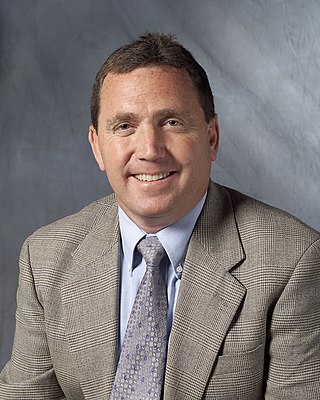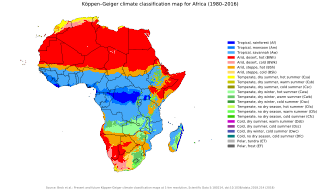Background
| | This section is empty. You can help by adding to it. (December 2022) |
David H. Douglass | |
|---|---|
| Born | 1932 (age 90–91) |
| Alma mater | University of Maine, MIT |
| Scientific career | |
| Fields | Solid-state physics |
| Institutions | University of Rochester |
| Thesis | Antiferromagnetic resonance in manganous chloride (1959) |
David H. Douglass (born 1932) is an American physicist at the University of Rochester.
| | This section is empty. You can help by adding to it. (December 2022) |
A 2005 study by Douglass and fellow University of Rochester physicist Robert S. Knox argued that global climate models underestimated the climate response to the 1991 eruption of Mount Pinatubo. The study also contended that global temperature returned to normal much faster after the eruption than the models had predicted. [1] [2]
A 2007 paper by Douglass and coworkers questioned the reliability of 22 of the most commonly used global climate models analyzed by Benjamin D. Santer and used by the IPCC to predict accelerated warming in the troposphere. [3] [4] The study had originally been submitted to Geophysical Research Letters the previous year, but was rejected in September 2006 on Santer's recommendation. [5] Santer and 17 co-authors later rebutted Douglass' paper. [6] [7]
Douglass was named a fellow of Alfred P. Sloan Foundation in 1963 [8] and elected a fellow of the American Physical Society in 1969. [9] He is a Fellow of the New York Academy of Sciences.

Efforts to scientifically ascertain and attribute mechanisms responsible for recent global warming and related climate changes on Earth have found that the main driver is elevated levels of greenhouse gases produced by human activities, with natural forces adding variability. The likely range of human-induced surface-level air warming by 2010–2019 compared to levels in 1850–1900 is 0.8 °C to 1.3 °C, with a best estimate of 1.07 °C. This is close to the observed overall warming during that time of 0.9 °C to 1.2 °C, while temperature changes during that time were likely only ±0.1 °C due to natural forcings and ±0.2 °C due to variability in the climate.

Benjamin David Santer is a climate researcher at Lawrence Livermore National Laboratory and former researcher at the University of East Anglia's Climatic Research Unit. He also worked at the Max Planck Institute for Meteorology from 1987 to 1992. He specializes mainly in statistical analysis of climate data sets, and detection/attribution of climate change forcings.

Climate is the long-term weather pattern in a region, typically averaged over 30 years. More rigorously, it is the mean and variability of meteorological variables over a time spanning from months to millions of years. Some of the meteorological variables that are commonly measured are temperature, humidity, atmospheric pressure, wind, and precipitation. In a broader sense, climate is the state of the components of the climate system, including the atmosphere, hydrosphere, cryosphere, lithosphere and biosphere and the interactions between them. The climate of a location is affected by its latitude, longitude, terrain, altitude, land use and nearby water bodies and their currents.

The global warming controversy concerns the public debate over whether global warming is occurring, how much has occurred in modern times, what has caused it, what its effects will be, whether any action can or should be taken to curb it, and if so what that action should be. In the scientific literature, there is a very strong consensus that global surface temperatures have increased in recent decades and that the trend is caused by human-induced emissions of greenhouse gases. No scientific body of national or international standing disagrees with this view, though a few organizations with members in extractive industries hold non-committal positions, and some have tried to persuade the public that climate change is not happening, or if the climate is changing it is not because of human influence, attempting to sow doubt in the scientific consensus.

Climate variability includes all the variations in the climate that last longer than individual weather events, whereas the term climate change only refers to those variations that persist for a longer period of time, typically decades or more. Climate change may refer to any time in Earth's history, but the term is now commonly used to describe contemporary climate change. Since the Industrial Revolution, the climate has increasingly been affected by human activities.

A stratovolcano, also known as a composite volcano, is a conical volcano built up by many layers (strata) of hardened lava and tephra. Unlike shield volcanoes, stratovolcanoes are characterized by a steep profile with a summit crater and periodic intervals of explosive eruptions and effusive eruptions, although some have collapsed summit craters called calderas. The lava flowing from stratovolcanoes typically cools and hardens before spreading far, due to high viscosity. The magma forming this lava is often felsic, having high to intermediate levels of silica, with lesser amounts of less viscous mafic magma. Extensive felsic lava flows are uncommon, but have travelled as far as 15 km (9 mi).

The instrumental temperature record is a record of temperatures within Earth's climate based on direct, instrument-based measurements of air temperature and ocean temperature. Instrumental temperature records are distinguished from indirect reconstructions using climate proxy data such as from tree rings and ocean sediments. Instrument-based data are collected from thousands of meteorological stations, buoys and ships around the globe. Whilst many heavily-populated areas have a high density of measurements, observations are more widely spread in sparsely populated areas such as polar regions and deserts, as well as over many parts of Africa and South America. Measurements were historically made using mercury or alcohol thermometers which were read manually, but are increasingly made using electronic sensors which transmit data automatically. Records of global average surface temperature are usually presented as anomalies rather than as absolute temperatures. A temperature anomaly is measured against a reference value. For example, a commonly used baseline period is the time period 1951-1980.

The first systematic measurements of global direct irradiance at the Earth's surface began in the 1950s. A decline in irradiance was soon observed, and it was given the name of global dimming. It continued from 1950s until 1980s, with an observed reduction of 4–5% per decade, even though solar activity did not vary more than the usual at the time. Global dimming has instead been attributed to an increase in atmospheric particulate matter, predominantly sulfate aerosols, as the result of rapidly growing air pollution due to post-war industrialization. After 1980s, global dimming started to reverse, alongside reductions in particulate emissions, in what has been described as global brightening, although this reversal is only considered "partial" for now. The reversal has also been globally uneven, as the dimming trend continued during the 1990s over some mostly developing countries like India, Zimbabwe, Chile and Venezuela. Over China, the dimming trend continued at a slower rate after 1990, and did not begin to reverse until around 2005.
John Raymond Christy is a climate scientist at the University of Alabama in Huntsville (UAH) whose chief interests are satellite remote sensing of global climate and global climate change. He is best known, jointly with Roy Spencer, for the first successful development of a satellite temperature record.

Kevin Edward Trenberth was part of the Climate Analysis Section at the US NCAR National Center for Atmospheric Research. He was appointed Distinguished Scholar at NCAR in 2020. He is also an honorary faculty in the Physics Departmentat the university of Auckland, Auckland, New Zealand. He was a lead author of the 1995, 2001 and 2007 IPCC Scientific Assessment of Climate Change and served on the Scientific Steering Group for the Climate Variability and Predictability (CLIVAR) program. He chaired the WCRP Observation and Assimilation Panel from 2004 to 2010 and chaired the Global Energy and Water Exchanges (GEWEX) scientific steering group from 2010 to 2013. In addition, he served on the Joint Scientific Committee of the World Climate Research Programme, and has made significant contributions to research into El Niño-Southern Oscillation.

Gavin A. Schmidt is a British climatologist, climate modeler and Director of the NASA Goddard Institute for Space Studies (GISS) in New York, and co-founder of the award-winning climate science blog RealClimate.
Dr. Patrick N. Keating was a theoretical physicist who contributed to several fields of solid-state physics, including semiconductors, semi-insulators and the basic properties of solid materials, and to other fields including optics, liquid crystals, acoustic holography, and signal processing. He was best known for the Keating Model of interatomic forces in tetrahedrally-coordinated solids.

Microwave Sounding Unit temperature measurements refers to temperature measurement using the Microwave Sounding Unit instrument and is one of several methods of measuring Earth atmospheric temperature from satellites. Microwave measurements have been obtained from the troposphere since 1979, when they were included within NOAA weather satellites, starting with TIROS-N. By comparison, the usable balloon (radiosonde) record begins in 1958 but has less geographic coverage and is less uniform.

The climate of Africa is a range of climates such as the equatorial climate, the tropical wet and dry climate, the tropical monsoon climate, the semi-arid climate, the desert climate, the humid subtropical climate, and the subtropical highland climate. Temperate climates are rare across the continent except at very high elevations and along the fringes. In fact, the climate of Africa is more variable by rainfall amount than by temperatures, which are consistently high. African deserts are the sunniest and the driest parts of the continent, owing to the prevailing presence of the subtropical ridge with subsiding, hot, dry air masses. Africa holds many heat-related records: the continent has the hottest extended region year-round, the areas with the hottest summer climate, the highest sunshine duration, and more.
Explosive volcanic eruptions affect the global climate in several ways.

Gabriele Clarissa Hegerl is a German climatologist. She is a professor of climate system science at the University of Edinburgh School of GeoSciences. Prior to 2007 she held research positions at Texas A&M University and at Duke University's Nicholas School of the Environment, during which time she was a co-ordinating lead author for the Intergovernmental Panel on Climate Change (IPCC) Fourth and Fifth Assessment Report.
Ingeborg Auer is an Austrian climatologist, known for her work on Project HISTALP.
Jacob Sebastian Haugaard Mernild is a Danish professor in climate change, glaciology and hydrology, who is the pro-vice-chancellor of the University of Southern Denmark. Mernild has been an Intergovernmental Panel on Climate Change (IPCC) author for the United Nations since 2010. Initially a contributing author on the IPCC Fifth Assessment Report, he was lead author on the IPCC Sixth Assessment Report.
Lisa Victoria Alexander is an international expert on heatwaves. She received the Dorothy Hill Medal for her research on climate extremes, the frequency and intensity of heatwaves, and has provided evidence that the frequency and intensity of heatwaves will be influenced by the quantity of anthropogenic greenhouse gas emissions, in particular carbon dioxide. She was a contributing author to the Intergovernmental Panel on Climate Change (IPCC) reports, including the fifth assessment report.
Georgiy L. Stenchikov is an applied mathematician and climate scientist focusing on studies of physical processes that govern the Earth's climate. He is a professor in the Department of Earth Science and Engineering at the King Abdullah University of Science and Technology in Saudi Arabia.